|
|
|
Sort Order |
|
|
|
Items / Page
|
|
|
|
|
|
|
| Srl | Item |
| 1 |
ID:
135685


|
|
|
|
|
| Summary/Abstract |
Islamic State’s presence in south Asia is on the rise, and increasing number of young people are being radicalised and joining the group. Bidhu Prashad Routray examines Islamic State’s expansion and the rising threat it poses to the region.
|
|
|
|
|
|
|
|
|
|
|
|
|
|
|
|
| 2 |
ID:
134631
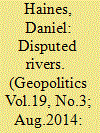

|
|
|
|
|
| Summary/Abstract |
The construction of territorial sovereignty is key to conceptions of modern states. Yet after the Partition of India and Pakistan in 1947, when both became independent from Britain, the precise nature of India’s relationship to Pakistan was open to some question. Was Pakistan a foreign country? Was India’s relationship to it international? This article uses the example of a dispute over water resources in the Indus Basin to highlight the process through which Indian officials in New Delhi’s External Affairs and Law ministries came to define Pakistan as constitutionally, as well as geographically, “outside” India between 1948 and 1951. Yet while Indian policy makers manoeuvred into an aggressive stance against Pakistan, both countries’ membership of the British Commonwealth implied an international relationship blurring the formal distinction between “domestic” and “foreign”. Negotiating the contradictions between Commonwealth rules and the desire to assert sovereignty over territory and resources, I argue, made Indian sovereignty contingent on circumstance.
|
|
|
|
|
|
|
|
|
|
|
|
|
|
|
|
| 3 |
ID:
135168


|
|
|
|
|
| Summary/Abstract |
In April 2011, Pakistan declared that it had tested a short-range battlefield nuclear missile, the Nasr.1 Since then, prominent purveyors of Pakistani nuclear doctrine, including Lieutenant General Khalid Kidwai and former diplomat Maleeha Lodhi, have portrayed the Nasr missile as a counter to India’s “Cold Start” war doctrine.2
That doctrine supposedly aims at rapid but limited retaliatory incursions into Pakistan by the Indian army to seize and hold narrow slices of territory in response to a terrorism event in India involving Pakistanis. The rationale is that the seized territory would be returned in exchange for Pakistani extradition of extremists inflicting terrorism onto India. The doctrine is based on the assumption that Pakistan would not resort to the use of nuclear weapons in response to a limited Indian incursion, thereby offering space for conventional conflict even in a nuclearized environment.
Pointing to this Indian war doctrine, Pakistani decision-makers now argue that the deterrent value of their current arsenal operates only at the strategic level. According to this line of reasoning, the gap at the tactical level gives India the freedom to successfully engage in limited Cold Start-style military operations without fear of nuclear escalation. Development of the low-yield, tactical battlefield nuclear weapon, the Nasr missile, is seen as the solution providing “flexible deterrence options”3 for an appropriate response to Cold Start, rather than massive nuclear retaliation against India. Nasr proponents argue that by maintaining “a credible linkage between limited conventional war and nuclear escalation,” the missile will deter India from carrying out its plan.4
This approach might appear to be sensible, but it suffers from two important flaws. First, the Cold Start doctrine has not been actively implemented and therefore does not seem to represent a genuine threat to Pakistan. Second, battlefield nuclear weapons are a key part of the proposed solution, but it may be extremely difficult to establish a command and control system that would effectively preclude the possibility of an accidental or unauthorized launch.
|
|
|
|
|
|
|
|
|
|
|
|
|
|
|
|
| 4 |
ID:
136514
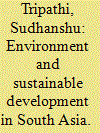

|
|
|
|
|
| Summary/Abstract |
The problem of environmental degradation affecting ecological balance in South Asia has its roots in several factors particularly socio-economic backwardness, lack of popular participation in policy formation and lack of collective effort at national as well as regional level. Acorrective to this situation wouldbe proper utilisation of the forum of SAARC and also developing partnership among public, industry and government for achieving sustainable development assuring human well-being.
|
|
|
|
|
|
|
|
|
|
|
|
|
|
|
|
| 5 |
ID:
136655


|
|
|
|
|
| Summary/Abstract |
Nepal shares an open border of 1,868 km with five Indian states (Uttarakhand, Uttar Pradesh, Bihar, West Bengal and Sikkim) and 1,415 km with Tibet. Under the 1950 Treaty of Peace and Friendship with India, Nepali citizens enjoy ‘national’ treatment and Nepali businesses unhindered rights of trade, transit and movement. An estimated six million Nepalese live and work in India and contribute to their inward remittances. Social intercourse along the Gangetic plane is described by people as ‘roti-beti ka sambandh’ (a RELATIONSHIP based on sharing of hearth and marriage). Predominantly a land of believers of Hinduism and Buddhism, Nepal shares a long and enduring cultural history with India. The Hindus of India hold Pashupatinath in high esteem and those of Nepal the Char Dham of India (the four important abodes of the Hindu pantheon in India, namely Jagannath Puri, Dwarka, Rameswaram and Badrinath). Lumbini and Bodhgaya join the common ethos of Buddha’s life and teachings. About 40,000 Gurkha soldiers serve in the Indian army today.
|
|
|
|
|
|
|
|
|
|
|
|
|
|
|
|
| 6 |
ID:
136787


|
|
|
|
|
| Summary/Abstract |
The optimist views South Asia as a half-full glass while the pessimist views it as half-empty. The realist, however, drinks the water in the glass, and wisely quenches his thirst. If we remain stuck in a quagmire of despondency over runaway population growth, grinding poverty of a huge section of the population, and endless squabbles over historic wrongs, the future looks grim. But, if we think of the region as overwhelmingly youthful, charged with vitality and a can-do mentality, well-integrated into the global economy thanks to its large diaspora, brilliantly positioned between the energy rich West Asia and the manufacturing hub of East and South-East Asia, and fully committed to inclusive developmental goals, then South Asia can be the region of the future.
|
|
|
|
|
|
|
|
|
|
|
|
|
|
|
|
| 7 |
ID:
137119
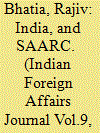

|
|
|
|
|
| Summary/Abstract |
South Asia’s environment, both internally and externally, has been changing rapidly. The growing Chinese presence in South Asia can be seen both positively as ‘a benign extension of influence’. Or negatively as ‘ingress’ with ‘a larger strategic purpose’. However, the important point is that it cannot be ignored. Nor can it be addressed with the mindset of yesterday. A judicious blend of resilience and the steady accretion of internal strength seem to be the best pathway for India.
|
|
|
|
|
|
|
|
|
|
|
|
|
|
|
|
| 8 |
ID:
135151


|
|
|
|
|
| Summary/Abstract |
India, which is ‘ground zero’ for climate change, has decided to reduce its carbon intensity, yet an important element of environmental efficiency neglected by India’s climate plan is the very way India designs itself. India’s recent development has focused not on ‘cities’ but on ‘metropolitan regions’ that include suburbs and exurbs. Such low-density growth increases oil consumption for car usage while neglecting the high-density based informal economy that is a source of India’s economic vitality and sustainable innovation. One important contribution of this economy is a vast recycling industry in which discarded materials are reprocessed, reused and returned to the market, effectively saving carbon space. An important way forward would be to integrate the informal sector into planning, by encouraging medium-density growth enabled by comfortable and efficient mass transit, following northern European rather than American planning patterns. Since environmental shifts may be inevitable, pre-emptive political and resource management arrangements must play a central role in India’s climate change adaptation plan.
|
|
|
|
|
|
|
|
|
|
|
|
|
|
|
|
| 9 |
ID:
136797
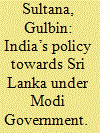

|
|
|
|
|
| Summary/Abstract |
As far as India’s foreign relations are concerned, it has been observed that regime change does not necessarily lead to the change of foreign policy. In most of the cases there is continuity. India’s relations with Sri Lanka under the United Progressive Alliance (UPA) government were marked by cooperation and understanding as well as disappointment and dissatisfaction.
|
|
|
|
|
|
|
|
|
|
|
|
|
|
|
|
| 10 |
ID:
136633
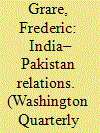

|
|
|
|
|
| Summary/Abstract |
As the new Indian government has settled in, what will happen to its relations with Pakistan? While some take comfort in the idea that the strong nationalist credentials of the new Prime Minister could facilitate a peace agreement with Pakistan, others argue that the risk of communal violence created by the Hindutva ideology1 of the new government could be a potential impediment to better India–Pakistan relations. But the evolution of the bilateral relationship is unlikely to depend on either of these considerations; it is also unlikely to depend primarily on New Delhi.
Narendra Modi's decision to invite his Pakistani counterpart, Nawaz Sharif, to his May 26, 2014, swearing-in ceremony, along with all the other heads of state or government from the South Asian Association for Regional Cooperation (SAARC), was considered a positive gesture on both sides of the border. The meeting between the two Prime Ministers was cordial and frank but—to no one's surprise—not groundbreaking. However, the two countries have already interpreted this early meeting differently.
|
|
|
|
|
|
|
|
|
|
|
|
|
|
|
|
| 11 |
ID:
136802


|
|
|
|
|
| Summary/Abstract |
The crisis which is engulfing a large swath of territories in Iraq and Syria has become a matter of global concern. The phenomenon called Islamic State of Iraq and Syria (ISIS) has created waves across different parts of the globe. Beyond its epicentre, that is, West Asia, its tentacles have reached South Asia, and India is no exception to it. India has recently witnessed a few ISIS-related activities and such influence of this Sunni militant group has drawn the attention of the security establishments in the country.
|
|
|
|
|
|
|
|
|
|
|
|
|
|
|
|
| 12 |
ID:
136948


|
|
|
|
|
| Summary/Abstract |
The South Asian communities who came to post-war Britain had numerous ways of maintaining links with ‘home’ even as they put down new roots. One conduit through which the interplay between old and new homes was reproduced was through the love of CRICKET many brought with them. The moral and ethical codes, which underpin much CRICKETING discourse, provided a language through which to reinscribe ideas of identity and belonging. CRICKET helped create social networks and diasporic connectivity. These affective relations gave rise to South Asians who are today multiply rooted; secure in their Indian or Pakistani ‘national’ identities, at times identifying as a South Asian diaspora, but nevertheless also ‘loyal’ citizens of Britain. The story of South Asians and their relationship with cricket in post-war Britain sheds light on the complex politics of belonging in the post-colony, and illustrates that diaspora is ultimately an unstable assemblage of collective association.
|
|
|
|
|
|
|
|
|
|
|
|
|
|
|
|
| 13 |
ID:
134957


|
|
|
|
|
| Summary/Abstract |
Millions of job seekers in South Asia, including many tribals, are forced by lack of local employment opportunities to migrate towards urban areas. This fieldwork-based study aims to understand specifically which factors influence job search processes among tribals from two states in India—Jharkhand and West Bengal. It examines their reasons for moving and factors on which job search depends, methods adopted in job search, the extent of different options and limitations because of the nature of jobs available and the skills levels of the people concerned. Based on these ethnographic findings, some policy concerns are raised in terms of monitoring of migration and protection of food security for tribal communities and other structurally disadvantaged rural people in South Asia.
|
|
|
|
|
|
|
|
|
|
|
|
|
|
|
|
| 14 |
ID:
134488
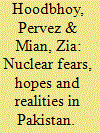

|
|
|
|
|
| Summary/Abstract |
In the four decades since Pakistan launched its nuclear weapons program, and especially in the fifteen years since the nuclear tests of 1998, a way of thinking and a related set of feelings about the bomb have taken hold among policy-makers and the public in Pakistan. These include the ideas that the bomb can ensure Pakistan's security; resolve the long-standing dispute with India over Kashmir in Pakistan's favour; help create a new national spirit; establish Pakistan as a leader among Islamic countries; and usher in a new stage in Pakistan's economic development. None of these hopes has come to pass, and in many ways Pakistan is much worse off than before it went nuclear. Yet the feelings about the bomb remain strong and it is these feelings that will have to be examined critically and be set aside if Pakistan is to move towards nuclear restraint and nuclear disarmament. This will require a measure of stability in a country beset by multiple insurgencies, the emergence of a peace movement able to launch a national debate on foreign policy and nuclear weapons, and greater international concern regarding the outcomes of nuclear arms racing in South Asia.
|
|
|
|
|
|
|
|
|
|
|
|
|
|
|
|
| 15 |
ID:
137123


|
|
|
|
|
| Summary/Abstract |
What of the future? Most importantly, unless Pakistan changes course radically towards India, SAARC as SAARC will essentially limp along. Even if India takes initiatives in the interests of the region, Pakistan will stymie them as it will not want India’s ‘hegemony’ to be consolidated. Pakistan’s attitude will not change unless it’s internal polity changes. This is not likely to happen given the dynamics inside Pakistan and the broader Islamic region with which it associates itself.
At the Kathmandu summit, India warned that regional integration will proceed with all, or without some, which suggests that if Pakistan does not cooperate, others can go ahead without it. If that happens, it will mean, of course, the emasculation of the idea of SAARC. However, Pakistan will not be easily isolated, as most other SAARC countries will seek to keep it involved in order to balance India’s weight. Side-tracking Pakistan will also mean that the integration of Afghanistan into SAARC will become practically impossible. BIMSTEC, which groups all SAARC countries except Pakistan and Maldives, provides an option for regional cooperation for India and others, with the added advantage of providing a seamless link to Southeast Asia through Myanmar and Thailand, the other two members of BIMSTEC. The SAARC charter does provide for sub-regional cooperation, but with the concurrence of the rest. This makes Pakistan’s role a major road block.
|
|
|
|
|
|
|
|
|
|
|
|
|
|
|
|
| 16 |
ID:
134907


|
|
|
|
|
| Summary/Abstract |
In February 1967, officials from the Central Intelligence Agency (CIA) were horrified when the American west-coast magazine, Ramparts, exposed the U.S. intelligence organization's longstanding financial relationships with a number of international educational institutions and cultural bodies. In a series of articles, reproduced in The New York Times and The Washington Post, Ramparts documented the CIA's provision of covert funding to, among others, the National Students Association, Asia Foundation, and Congress for Cultural Freedom (CCF). In India, an outpouring of public indignation ensued when it became clear that the Indian Committee for Cultural Freedom, a local offshoot of the CCF, had accepted money from the CIA. The global spotlight cast upon some of the CIA's more questionable activities had a profound and enduring impact upon Indian perceptions of the United States' government and its external intelligence service. In the wake of the Ramparts scandal, the CIA came to occupy a prominent place in Indo–U.S. cultural and political discourse. For the remainder of the twentieth century, and beyond, anti-American elements inside and outside India drew repeatedly upon the specter of CIA subversion as a means of undermining New Delhi s relationship with Washington.
|
|
|
|
|
|
|
|
|
|
|
|
|
|
|
|
| 17 |
ID:
137121


|
|
|
|
|
| Summary/Abstract |
SAARC has not really realised its full potential because conditions do not exist in the neighbourhood for economic cooperation. Bilateral disputes plague the association and, without mutual trust, no regional organisation can function effectively. India has gained more by its association with the ASEAN rather than with SAARC. Even the declarations of SAARC are rarely implemented
Prime Minister Narendra Modi’s vision of SAARC becoming a corner stone of India’s foreign policy has already suffered a setback. Pakistan raised bilateral issues on the floor of the United Nations even in September 2014, thus violating the spirit of bilateralism and regional cooperation. Other states in the region are also not ready yet to work in a spirit of cooperation. In the meantime, SAARC can operate only on the basis of the lowest common denominators among its members. India would continue to improve its relations with each of its neighbours so that SAARC could become a true regional organisation like the European Union or the ASEAN. In the current situation in the Asia Pacific, characterised by rivalry between the US and China, such a transformation may be hard to accomplish.
|
|
|
|
|
|
|
|
|
|
|
|
|
|
|
|
| 18 |
ID:
137120
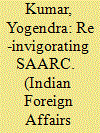

|
|
|
|
|
| Summary/Abstract |
It is now universally recognised that the regional cooperation in South Asia is far less developed in comparison to other regions. There is irony in this situation, as countries in the region have very strong historical and civilisational links even as they occupy the same economic space. These regional commonalities were sought to be fleshed out through the establishment of the South Asian Association for Regional Cooperation (SAARC) in December 1985. It was expected that these commonalities would provide a strong enough basis for significant regional integrationas, indeed, it was before 1947and for socio-economic progress, thereby strengthening regional political stability by keeping the negative tendencieslike backwardness, obscurantism and extremismat bay.
Yet, the sad reality is that other regional organisations, such as the European Union and the ASEANcomprising an even more diverse group of countrieshave been far more successful than SAARC. Indeed, the latter could, perhaps, be less favourably compared even with more recent organisations such as the African Union or the ECO. As an organisation, SAARC has underperformed throughout its history, and the level of regional integration is woefully short of its promise. Even its summits are becoming irregular. Perhaps, the unsatisfactory level of regional integration can partly be considered as a contributory factor in the prevailing situation where the region represents a microcosm of the range of security threats being faced by the world at large. This reality appears even more distressing, given the considerable ongoing movement of peoples in South Asia across borders, and the phenomenon of very easy social relationships overseas amongst members of the respective Diasaporas..
|
|
|
|
|
|
|
|
|
|
|
|
|
|
|
|
| 19 |
ID:
137118


|
|
|
|
|
| Summary/Abstract |
The business-as-usual option forces member states and the secretariat to, willy-nilly, reduce the entire regional exercise to a talk shop of many levels, the summit being the topmost. At the same time, it is difficult to abandon this framework since no country would take the blame for doing it. While there are a number of other regional and sub-regional options actively considered and debated in think tanks and academia, the brute fact is that their praxis may not differ much from that of SAARC. This is because it is the same ministries and personnel in the capitals who deal with even the new formats, and mostly the same ideas and initiatives resurface. Take, for example, BIMSTEC. In the past several years, even BIMSTEC has fallen in a similar groove of a well trodden economic agenda, trade and infrastructure, investment, banking, etc., and similarly, a fledgling secretariat fumbling for staff and resources, and not much to show. The Indian Ocean Rim outfit has even larger membership, but similar handicaps.
It is, therefore, unrealistic to see alternatives to SAARC emerge successfully unless very high level interest is taken in a continuous process which begins with a doable and less ambitious agenda hooked to the quick delivery of results. In this sense, there is no doubt that bilateral cooperative processes move faster; but, should that put an end to regionalism?
|
|
|
|
|
|
|
|
|
|
|
|
|
|
|
|
| 20 |
ID:
137124
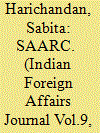

|
|
|
|
|
| Summary/Abstract |
SAARC is not a forum for clearing Indo-Pak distrust; it stands for far greater regional interests. No country should be allowed to be a spoiler of this serious agenda. Being the two most important members of the regional association, both India and Pakistan shoulder a special responsibility to instil new life and vigour in regional cooperation and go beyond paying lip service to it. Subramanian Swamy, the Chairman of the Bharatiya Janata Party’s Strategic Affairs Committee, commented in The Hindu on 25 November 2014, “Since India constitutes 70 per cent or more of SAARC’s area and population, and has political conflicts with all its neighbours, India has to redefine its role, from seeking reciprocity in bilateral relations, to being prepared to go the extra mile in meeting the aspirations of all other SAARC nations.”. The greater regional interests should not be sacrificed at the altar of the intransigent attitudes of some member nations of SAARC.
|
|
|
|
|
|
|
|
|
|
|
|
|
|
|
|
|
|
|
|
|